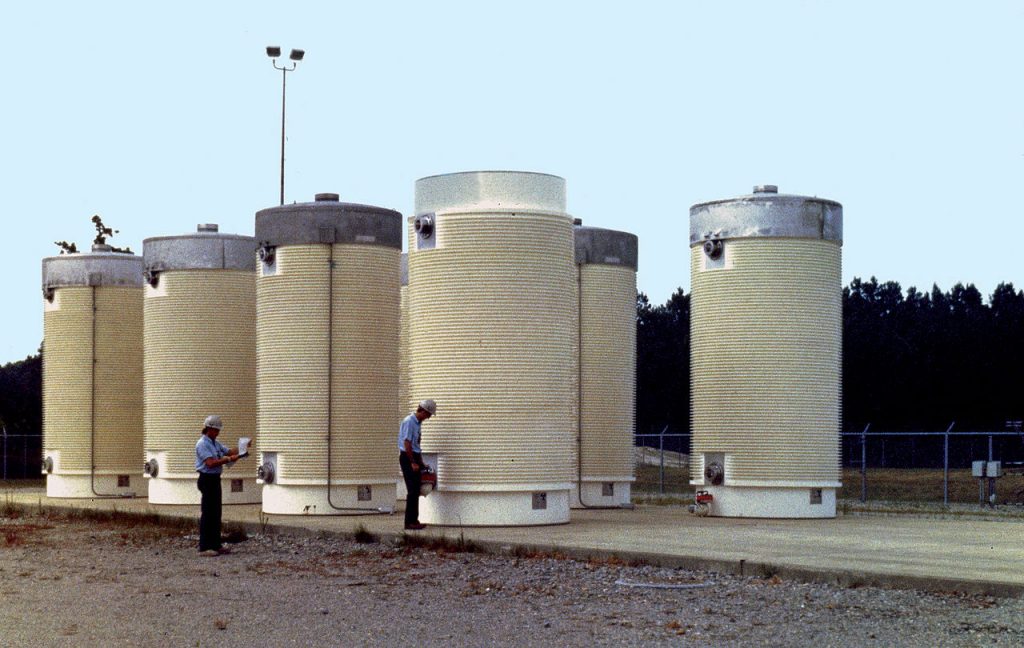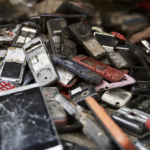Will nuclear waste disposal challenges limit a significant expansion of global nuclear power?
By Aleksandr Kudryavtsev, Masha Levon, T. Gannon Parker, Viktor Rosnovskii | June 20, 2019

While nuclear power is a sustainable alternative source of energy to the burning of fossil fuels, there are clear challenges associated with the disposal of spent (used) nuclear fuel and high-level waste generated during reprocessing of spent fuel. Nuclear waste disposal is compounded by an unfortunate fact: Even countries with established nuclear programs do not have permanent repositories for spent nuclear fuel and high-level waste. Nevertheless, we conclude that interim measures such as dry cask storage on the path to permanent solutions will allow countries to expand nuclear power to mitigate the imminent threat of global climate change.
As of December 2013, the International Atomic Energy Agency (IAEA) reports an estimated 250,000 tons heavy metal of spent fuel in storage worldwide and 120,000 tons of heavy metal of reprocessed spent fuel. Of the solid nuclear waste resulting from nuclear operations, more than 98 percent is classified as being very-low- or low-level waste in volume terms, with most of the remainder being intermediate-level waste, all of which can be disposed safely.
Spent nuclear fuel and high-level waste are the most problematic in that they require isolation and permanent disposal, but they are currently in interim storage because no permanent solutions have been implemented. Such storage sites include containment pools at the reactor plant for spent fuel until it has cooled (both thermally and radioactively) for several years followed by storage in dry casks for a relatively long-term (perhaps on the order of a century, but explicitly not permanent).
A number of permanent nuclear waste disposal options (as summarized by the World Nuclear Association) have been proposed over time, including disposal at sea, disposal in subduction zones, disposal in outer space, and disposal by deep well injection. However, all of these options have been scrapped because they were deemed impractical, not economical, unsafe, environmentally destructive, or in violation of international agreements. The development of deep geological repositories is currently the favored long-term solution among developed nations with civilian nuclear programs.
Several nations are currently either constructing or planning sites for deep geological repositories for long-term storage of nuclear waste, most notably Finland, Sweden, France, and Canada. Finland is the most advanced with the construction of the Onkalo spent nuclear fuel repository. For the Swedish and French storage schemes, sites have been identified (Forsmark and Cigéo, respectively) and licensing processes are underway, with Sweden’s expected to be completed next year.
Experience in the United States has been disappointing. After spending decades and billions of dollars to research potential sites for a permanent repository site, including at the Yucca Mountain site in Nevada, the future prospects for permanent disposal remain unclear. A recent study led by Stanford and George Washington University scholars concludes “after more than thirty years of effort, there is still no clear way forward for the selection, characterization and development of a geologic repository for spent nuclear fuel and high-level nuclear waste.” The study calls for a complete reset of nuclear waste management in the United States because of what it views as significant and almost insurmountable challenges.
Russia has taken a very different approach to managing spent fuel and nuclear waste. It considers spent fuel as a valuable energy resource because typical reactor operations today consume less than 1 percent of the available energy of the uranium fuel before it has to be removed from the reactor. The United States has chosen to dispose of the spent fuel at this point because reprocessing—that is, separating the recyclable elements such as plutonium from the rest—is considered to pose an unacceptable proliferation risk. It also considers recycling to be uneconomical. Russia, on the other hand, views spent fuel to be a valuable energy resource, particularly if the recovered plutonium is used for fuel in fast reactors. It also believes that the proliferation risks of reprocessing are manageable. These views are shared by the French government, which has recycled its spent fuel for many years.
The Russian government and its state-owned nuclear enterprise Rosatom believe that reprocessing for closed fuel-cycle operations will significantly reduce the amount of high-level waste produced, although the amount of low- and intermediate-level waste will increase. Rosatom has plans to have fast reactors work in parallel with numerous light water reactors to recycle plutonium so as to produce virtually no accumulated spent nuclear fuel. This strategy would reduce the waste volume and mass, radiotoxicity, and decay heat by removing minor actinides from spent fuel, reducing the requisite storage period, and therefore reducing the cost, size, and security requirements for disposal options. Furthermore, from the Russian viewpoint, a successful fast breeder reactor program represents an almost inexhaustible, and therefore sustainable energy source.
Russia is moving ahead slowly, but deliberately with plans for construction of deep geological repositories for residual spent fuel and high-level waste. A demonstration project for a geologic repository for intermediate- and high-level wastes has been initiated at Krasnoyarsk, which mimics the granitic location of the Swedish and Finnish programs.
We believe that despite different approaches and policy perspectives there are reasonable paths forward for both Russia and the United States. Russia is moving ahead with a closed fuel cycle and reprocessing and is making progress toward an operational fleet of fast reactors as part of Rosatom’s Proryv (Breakthrough) project. The urgency for moving ahead with nuclear power expansion and an acceptable path forward for the disposition of spent fuel and high-level waste is underscored by the severe threat to the world’s climate from the burning of fossil fuels. We concur with the goals of the World Nuclear Association’s Harmony Program, which targets completely carbon-free electricity generation, with 25 percent provided by nuclear power and in harmony with renewable sources, by 2050.
The United States will have to reset its nuclear waste program and perhaps learn lessons from the Finnish experience. We concur with the MIT study that managed spent fuel storage in dry storage casks on the order of a century is feasible. During this time alternate technological options can be explored and eventually implemented since the spent fuel will be retrievable.
For nascent nuclear programs in developing nations, the most practical way forward in the near term is for states with the desire to develop civilian nuclear energy programs to have plans and infrastructure in place for dry cask storage. For the longer term, several concepts have been proposed to develop joint nuclear waste facilities among participating countries. Russia has taken a bold approach by offering to help countries to which it supplies reactor and fuel-cycle technologies and materials. Russia has agreed to take back the spent fuel and reprocess it in order to diminish the burden of the lessee of storing the waste.
However daunting the picture of permanent storage of spent nuclear fuel and high-level waste may be, it need not and should not distract from the more pressing issue of solving the global energy crisis and mitigating the effects of climate change, which we consider to pose serious environmental dangers even in the near term. The damage done by climate change could have devastating, possibly permanent repercussions, the extent of which is not yet understood. A plan should be set in place that allows for new nuclear programs to be developed, using interim waste storage until a permanent solution is achieved. With continuing and hopefully improving cooperation between developed nations (especially between the United States and Russia) with regard to long-term waste storage, a cooperative solution to the nuclear waste problem will likely be found.
Together, we make the world safer.
The Bulletin elevates expert voices above the noise. But as an independent nonprofit organization, our operations depend on the support of readers like you. Help us continue to deliver quality journalism that holds leaders accountable. Your support of our work at any level is important. In return, we promise our coverage will be understandable, influential, vigilant, solution-oriented, and fair-minded. Together we can make a difference.
Topics: Analysis, Climate Change, Nuclear Energy, Voices of Tomorrow



















“Will nuclear waste disposal challenges limit a significant expansion of global nuclear power?”
One can only hope.
There is a nuclear repository plan from Germany that looks very promising.
DBHD – Deep Big Hole Disposal – Diameter 12 Meter drilling technology –
very deep watercooled shaft mine building site.
Perfect closure by mountain pressure in rocksalt LAYER